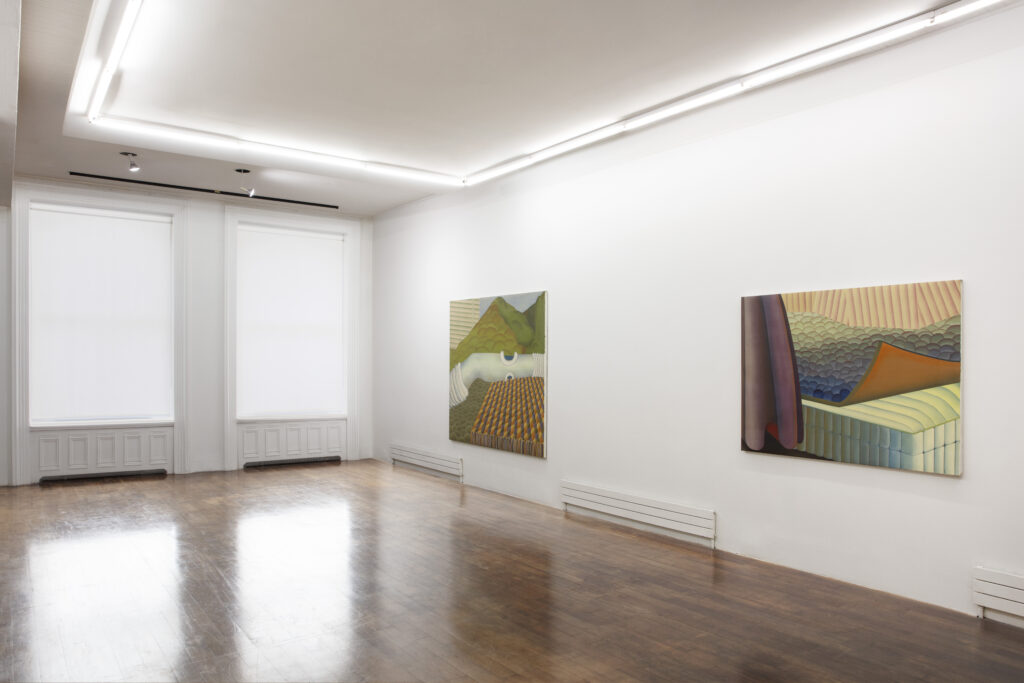CYNTHIA CARLSON
EARLY WORKS
DUANE THOMAS GALLERY
RECEPTION FEBRUARY 23rd, 2024
6/8pm

Cynthia Carlson, a Chicago native, graduated from the Art Institute in the mid-sixties. During her time there, she connected with artists who later formed a group known as the Chicago Imagists. However, it was in New York, where she moved for graduate studies in 1970, that she embarked on a series of works forming the basis of our survey exhibition at Duane Thomas Gallery, aptly titled “Cynthia Carlson, Early Works.” The show is now open, and a reception for the artist is scheduled for February 23rd at our Tribeca location from 6 to 8 pm. A newly published monograph by Rizzoli will be available for purchase and signing.
Characteristic of the surreal aesthetics of the Chicago painters of that period, Carlson’s works took a unique path. In a film from the time titled “Cynthia’s Ceremony,” the artist reflects, “I am a painter, a college art instructor, a woman, and a human being who has a life in New York City. I don’t think these different facets amount to a shattering whole, and I sometimes wonder if I should worry about it or not. Practically speaking, it is difficult being a woman and a serious painter simultaneously because people who know me in one role refuse to take me seriously in the other.”
In these works, surrealism might be considered an afterthought, possibly in response to the dominance of minimalism in the art world at the time. Carlson delved into her interest in vernacular architecture and her lifelong fascination with patterns, searching for contradictory spaces with no defined focal points and that later cemented her leading position in the Pattern and Decoration Movement. While semblances of figures might emerge, sometimes referenced in titles like “Leg,” “Dress,” “Mattress,” and “Foam,” they only serve as a premise for the development of a different kind of space—non-linear, non-narrative, yet familiar.
During her studio tour for a seminal exhibition at the Aldrich in 1971, Lucy Lippard recognized Carlson as a feminist master, including most of these works in the exhibition “26 Contemporary Women Artists,” possibly the first instance in America of a women-only show. The New York Times art critic Grace Glueck, struck by one of the works, “Untitled (Inscape) 1,” wrote, “there are unmistakable gynecological references, for example, in Cynthia Carlson’s biomorphic abstractions.” Alexis Clement, in a recent review of the Aldrich’s reboot of Lippard’s show, noted about Carlson’s work, “Untitled Inscape #1” (1970), “even without using literal representations of the body, strongly conjures the constant experience of women’s bodies being examined, explored, and pulled apart.”
For Carlson, while feminism was of concern, particularly at a time when women comprised only 4% of the selection for the Whitney Biennale in 1971, a sense of disjunction closer to the French New Wave and the emancipating spirit of the late sixties aligns more closely with the original intent.
A small work in the exhibition titled “First in Line” is nearly entirely abstract, where the pattern becomes a rhythm of its own, reminiscent of Jazz in its capacity to create mood through repetition.
The exhibition is open by appointment and will have a reception on February 23rd, 2024, in the presence of the artist. A recently published monograph by D.A.P will be available for purchase and signing.



